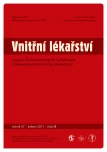Sulodexid and nephrotic syndrome in patients with diabetic nephropathy
Authors:
I. Valočiková
Authors‘ workplace:
I. Interná klinika Lekárskej fakulty UPJŠ a FN L. Pasteura Košice, Slovenská republika, prednostka prof. MUDr. Ivica Lazúrová, CSc.
Published in:
Vnitř Lék 2011; 57(5): 507-510
Category:
Case Reports
Overview
Diabetic nephropathy (DN) is the most serious, life limited complication of both types of diabetes mellitus. Therefore the early identification and intensive treatment of DN is very important. DN involves the thickening of glomerular basement membrane (GBM) and the depletion of glycosaminoglycan (GAG) in the GBM with resultant diminution in the physiological electrostatic charge barier. Additional mechanism in pathophysiology of DN is mesangial expansion. Sulodexide is glycosaminoglycan mixture of heparansulfate and dermatan sulfate. We present a 71-year old patient with severe nephrotic syndrome, probably caused by DN. AS patient refused renal biopsy, exact diagnosis of DN could not be confirmed. Since 2000 our patient was treated with sulodexide. More pronounced decrease of protenuria was proved 1.5 year after the begin of this treatment (from 10.37 g/d to 4.8 g/d) and after 3 years was proteinuria negative.
Key words:
nephrotic syndrome – diabetic nephropathy – sulodexid – regression of nephrotic syndrome
Sources
1. Brenner BM (ed.). Brenner and Rector’s The Kidney. 2 Volume Set. 8th Ed. 2008.
2. Parving HH, Hovind P, Roassing K et al. Evolving strategies for renoprotection: diabetic nephropathy. Curr Opin Nephrol Hypertens 2001; 10 : 515–522.
3. Villar E, Remontet L, Labeeuw M et al. Effects of age, gender and diabetes on excess death in end-stage renal failure. J Am Soc Nephrol 2007; 18 : 2125–2134.
4. Weis R, Niecestro R, Raz I. The Role of Sulodexide in the Treatment of Diabetic nephropathy. Drugs 2007; 67 : 2681–2696.
5. Jensen T. Pathogenesis of diabetic vascular disease: evidence for the role of reduced heparan sulfate proteoglycan. Diabetes 1997; 46 (Suppl 2): 98–100.
6. van den Hoven H, Rops M, Bakker M. Increased expression of heparinase in overt diabetic nephropathy. Kidney Int 2006; 70 : 2100–2108.
7. Parving HH, Osterby R, Anderson PW et al. Diabetic nephropathy. In: Brenner BM (ed.). The Kidney. 5th Ed. Philadelphia: WB Saunders Company 1996 : 1864–1891.
8. Taft JL, Nolan CJ, Young SP et al. Clinical and histological correlations of decline in renal function in diabetic patients with proteinuria. Diabetes 1994; 43 : 1046–1051.
9. The Diabetes Control and Complications Trial Research Group. The effect of intensive treatment of diabetes on the development and progression of long-term complications in insulin-dependent diabetes mellitus. N Engl J Med 1993; 329 : 977–986.
10. United Kingdom Prospective Diabetes Study (UKPDS) Group. Efficacy of atenolol and captopril in reducing risk of macrovascular and microvascular complications in type 2 diabetes. UKPDS 39. BMJ 1998; 317 : 713–720.
11. Brenner BM, Cooper ME, de Zeeuw D et al. RENAAL Study Investigators. Effects of losartan on renal and cardiovascular outcomes in patients with type 2 diabetes and nephropathy. N Engl J Med 2001; 345 : 861–869.
12. Lewis EJ, Hunsicker LG, Clarke WR et al. Collaborative Study Group. Renoprotective effect of the angiotensin-receptor antagonist irbesartan in patients with nephropathy due to type 2 diabetes. N Engl J Med 2001; 345 : 851–860.
13. Parving HH, Lehnert H, Bröchner--Mortensen J et al. Irbesartan in Patients with Type 2 Diabetes and Microalbuminuria Study Group. The effect of irbesartan on the development of diabetic nephropathy in patients with type 2 diabetes. N Engl J Med 2001; 345 : 870–878.
14. Ruggenenti P, Fassi A, Ilieva AP et al. Bergamo Nephrologic Diabetes Complications Trial (BENEDICT) Investigators. Preventing microalbuminuria in type 2 diabetes. N Engl J Med 2004; 351 : 1941–1951.
15. Lauver DA, Lucchesi BR. Sulodexide: A Renewed Interest in This Glykosaminoglycan. Cardiovasc Drug Rev 2006; 24 : 214–226.
16. Gambaro G, Venturini AP, Noonan DM et al. Treatment with glycosaminoglycan formulation ameliorates experimental diabetic nephropathy. Kidney Int 1994; 46 : 797–806.
17. Xu X, Rao G, Maxihimer JB et al. Mechanism of action of sulodexide-mediated control of diabetic proteinuria: inhibition of heparanase-1 activity. Abstract. J Am Soc Nephrol 2005; 16 : 673A.
18. Wang YQ, Liang KH, Pahl MV et al. Effect of heparin on mesangial cell growth and gene espression of matrix proteins. Nephrol Dial Transplant 1998; 13 : 3052–3057.
19. Barbanti M, Giuzzardi S, Calanni F et al. Antithrombotic and thrombolytic activity of sulodexide in rats. Abstract. Int J Clin Lab Res 1992; 22 : 179–184.
20. Buchanan MR, Liao P, Smith LI et al. Prevention of thrombus formation and growth by antithrombin III and heparin cofactor II-dependent thrombin inhibitors: importance of heparin cofactor II. Thromb Res 1994; 74 : 463–475.
21. Okša A, Ponťuch P, Kratochvílova H. Účinok glykozaminoglykanu sulodexidu na albuminúriu u pacientov s diabetes mellitus. Bratisl Lek Listy 1999; 9 : 486–489.
22. Gambaro G, Kinalska I, Oksa A et al. Oral Sulodexide Reduces Albuminuria in Microalbuminuric and Macroalbuminuric Type 1 and Type 2 Diabetic Patients: The Di.N. A.S. Randomized Trial. J Am Soc Nephrol 2002; 13 : 1615–1625.
23. Heerspink HL, Greene T, Lewis JB et al. Collaborative Study Group. Effects of Sulodexide in patients with type 2 diabetes and persistent albuminuria. Nephrol Dial Transplant 2008; 23 : 1946–1954.
24. Achour A, Kacem M, Dibej K et al. One year course of oral sulodexide in the management of diabetic nephropathy. J Nephrol 2005; 18 : 568–574.
25. Cortinovis M, Cattaneo D, Perico N et al. Investigational drugs for diabetic nephropathy. Expert Opin Investig Drugs 2008; 17 : 1487–1500.
Labels
Diabetology Endocrinology Internal medicineArticle was published in
Internal Medicine

2011 Issue 5
Most read in this issue
- Morbus Ormond (idiopatic retroperitoneal fibrosis)
- Cardiotoxicity of cancer therapy
- Internal medicine and cognitive decline in seniors
- Disturbance of synthesis of cholesterol and its precursors in clinically serious conditions
